As part of its strong brand identity, Great Wolf Lodge provides its regular customers a sense of familiarity across all of its resorts—from the water parks to the themed restaurants. But while common concepts and aesthetics may be deployed at each property, the actual buildings are far from prototypical designs.
“These are big, complex projects,” says Andrew Pigozzi, principal in charge at project design firm Stantec. “They are just as complicated as a hospital.”
At Great Wolf Lodge’s new 680,000-sq-ft resort in Perryville, Md., the typical challenges on its projects were amplified by supply chain issues, cost escalations and a tight labor market. Stantec and construction manager Turner Construction started work on the $250-million project prior to the pandemic. With construction documents at 80%, the project was forced to go on hold when pandemic shutdowns went into effect in March 2020. The pause gave the owner, Great Wolf Resorts, an opportunity to step back and reevaluate its plan.
“During the downtime, we took another look and the results were so favorable that we decided to add another 200 rooms and expand the water park by about 20%,” says Eden Deng, senior project executive at Great Wolf Resorts.
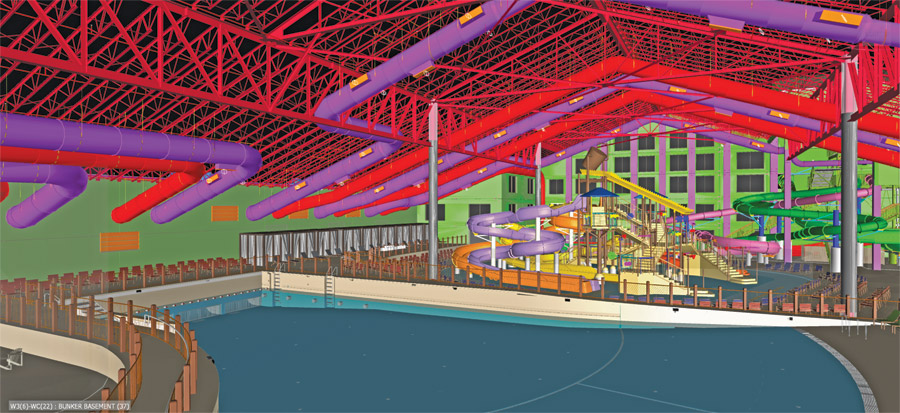
The water park required extensive coordination between the project's various specialty contractors.
Rendering by Stantec, courtesy of Turner Construction Co.
Great Big Plans
The resulting plan called for building the largest resort in the company’s portfolio. The property, which sits on 48 acres, includes a six-story, 700-room hotel; an 80-ft-tall, long-span indoor water park; and a single-story family entertainment center with arcades, an indoor climbing area, a mirror maze and multiple restaurants.
In light of the favorable outlook, Great Wolf Resorts wanted to restart the project as quickly as possible. The team began an intense six-month process of redesigning the project, taking into account new challenges around material availability and cost escalations.
Pigozzi says the team was able to extend the wings of the hotel to accommodate the extra rooms while keeping the building at the same height. The expanded water park, however, required a full redesign.
“We looked at trying to salvage the existing structural design and just add another couple of bays,” Pigozzi says. “That was not feasible because the lateral system wouldn’t have worked. We basically had to start over again and create a larger box for the water park.”
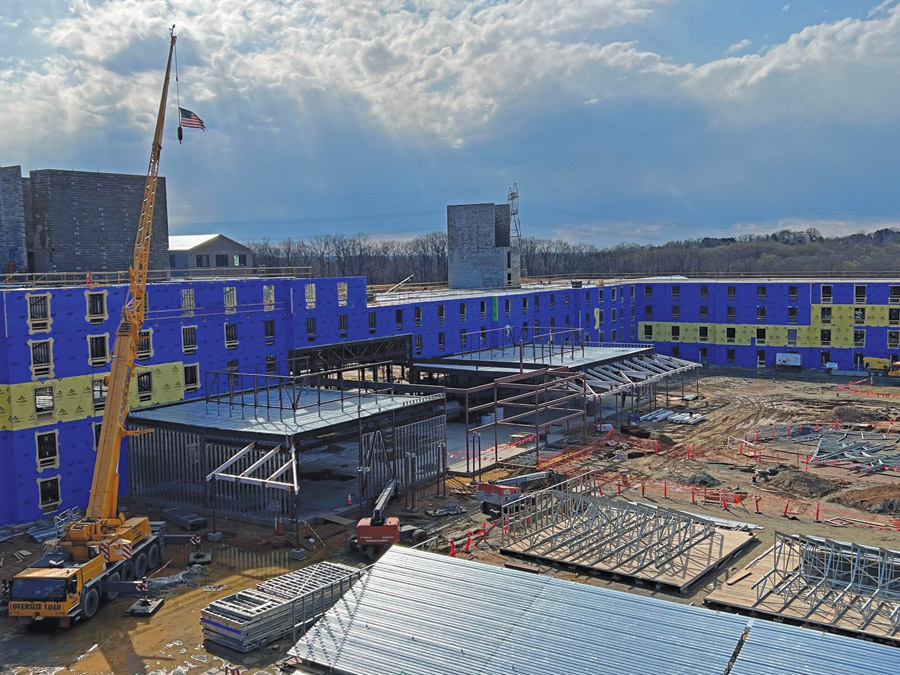
Structural steel was used for the lobby and family entertainment center, while the six-story hotel used a cold-form metal framing system.
Photo by Braxton Richardson, courtesy of Turner Construction Co.
The Steel Deal
Material choices, however, resulted in some of the most significant changes. With the industry facing widespread shortages of timber, Great Wolf Resort could not get affordable and easy access to one of its favored materials—glulam. The company particularly likes to specify glulam timber in its water parks because they are warm, wet environments where metal materials are more likely to corrode.
Still, pricing at the time was prohibitive enough that the team had to consider a steel option, says Braxton Richardson, senior project manager at Turner Construction. The affordable solution was bar joists and metal decking with three layers of high-performance coatings. The initial plan called for the manufacturer to paint the prime coat before shipping, but ultimately that did not fit the schedule. Instead, the bar joists were shipped and sent to a paint shop. The team had also planned to have crews add the extra coats in the field, but that created its own challenges.
“These are big, complex projects. They are just as complicated as a hospital.”
— Andrew Pigozzi, Principal in Charge, Stantec
“The water park is 80 ft tall at its peak, so getting up there to paint would be slow work and it’s out in the elements,” Richardson recalls. “We saw that train coming at us, so we elected to have the contractor spray both the prime coat and mid-coat in its facility.”
Richardson estimated that option could save a month in the schedule. The decision also came with some risks, however, as the coatings could be chipped in shipping.
“We developed a process for how to load their trucks with protection between the [bar joists] so we could get the product up here in the best possible condition,” he says. “Then we had to come up with special rigging processes so that it wouldn’t destroy the coatings. We did realize that there could be some damage that would have to be repaired, but we knew the time savings would be worth it in the end.”
Great Wolf Resorts hired its own National Association of Corrosion Engineers Level 3 inspector to ensure that the painted metal met quality assurance and quality control requirements. Repair procedures were developed, performed and inspected in collaboration with the paint manufacturer and the inspector. Crews performed repairs during night shifts to limit impact to other parts of the water park.
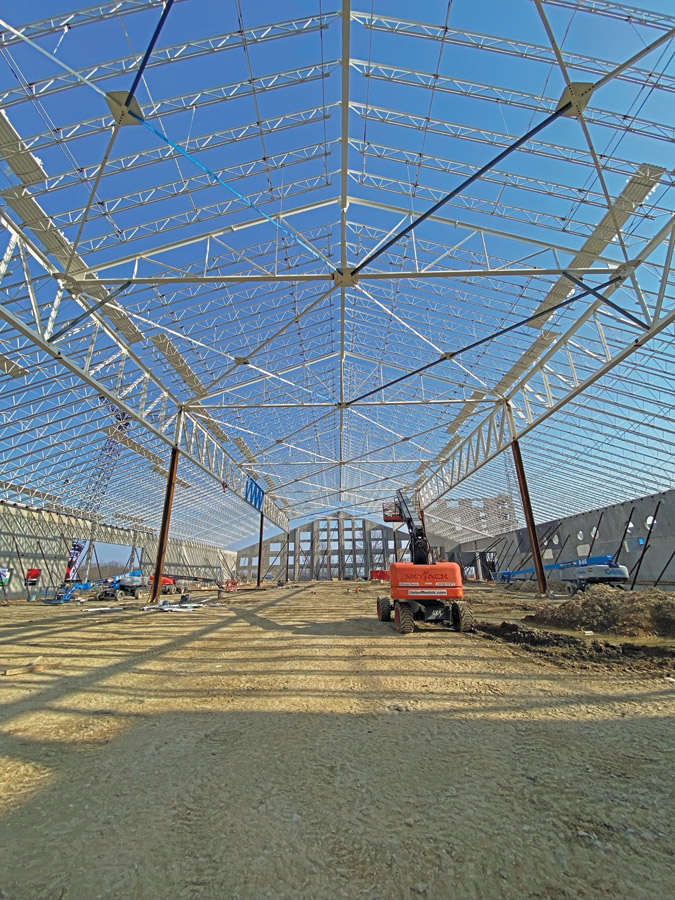
Although most Great Wolf Lodge water parks are glulam timber structures, the Perryville project is steel with protective coatings to shield against corrosion.
Photo by Multivista, courtesy of Turner Construction Co.
Although cumbersome, Richardson says the process ultimately saved budget and schedule.
For the Family Entertainment Center, crews installed structural steel with glulam timber placed on top of the steel to maintain the wood look.
The hotel, which was initially designed as structural steel, was redesigned as cold-form metal framing. The prefabricated system proved to be the most affordable choice, in part because of the speed of installation. Pigozzi says the trade-off of using the cold-form metal framing system is that the designs needed to be tightly coordinated so that all of the equipment and systems in the rooms would fit properly.
“The system is laid out very rigidly,” he says. “When the framing system goes in, you don’t have the ability to cut a stud or to bridge around it, so you have to work with the spacing that is designed.”
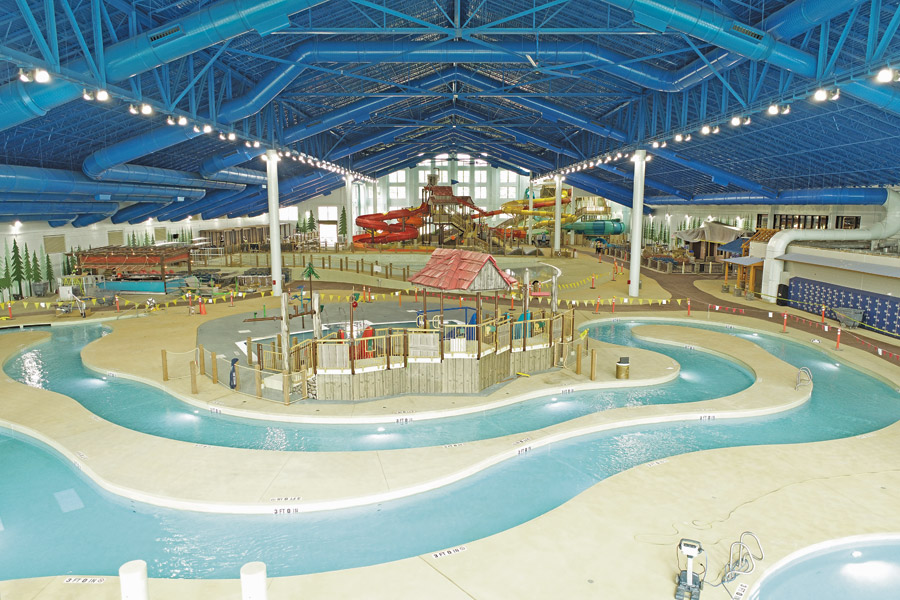
Keeping the water park on schedule was critical so spaces could be handed off to the pool contractor and the waterslide contractor.
Photo by Multivista, courtesy of Turner Construction Co.
Although the project came with significant challenges, the team was able to anticipate many of them, Richardson says. The Perryville resort is the seventh that Turner has built for Great Wolf Resorts. For each project, Turner uses its local teams to take on the work, rather than sending the same team to each new project. However, Richardson says Turner has developed a robust set of lessons learned from each project that is shared with each new team.
“Internally, we have a Great Wolf Lodge playbook where we share information between the business units,” he says. “That’s everything from architectural details that [the client] prefers to things that may not be on the construction documents. In some cases, documents may not exactly reflect the intent, but they expect Turner to understand that. So getting information from the teams that have built it before was critical.”
“We essentially got sign-off from the owner on four prototypes before we started any interior fit-out of the hotel.”
— Braxton Richardson, Senior Project Manager, Turner Construction
One key lesson learned is that the water park is the critical path. Specifically, Richardson says crews needed to prioritize the 25-ft-deep bunker under the water park, which would house mechanical equipment and other systems. “You have to get that bunker built so that you can get main mechanical penetrations through the foundation wall,” he says.
Keeping the water park on schedule was also important so that spaces could be handed off to the pool contractor—Newman Pools—and the waterslide contractor—ProSlide, both of which were contracted by Great Wolf Resorts, not Turner.
“[Those contractors] have a very set schedule,” he says. “There’s not much they can do to accelerate.”
Both Stantec and Turner also had to coordinate closely with ProSlide, which created precise designs for its slides that delicately blend an exciting experience for guests with safety measures.
“There are potentially big life-safety issues with slides, so you have to accommodate them,” Pigozzi says. “They gave us models with a very high degree of accuracy, and we had to make sure we met those needs.”
Making Mock-ups
The next critical component was the hotel. With 700 rooms, Richardson says that one error repeated in each room could create a disaster. Turner decided to spend a month creating full mock-ups of each of the four room types, working out all the kinks.
“These were 100% complete turnkey mock-ups,” he says. “We essentially got sign-off from the owner on four prototypes before we started any interior fit-out of the hotel. Once that was done, we were off to the races.”
Richardson says that between December 2022 and May 2023, crews were able to turn over between 30 and 50 rooms per week.
At its peak, last summer, the project’s workforce hit 550 people. Again, the team was able to leverage its lessons learned to address a common problem—parking for its workers. “When the hotel got started, we already had the parking lot graded and we were starting to run curb and gutter,” Richardson says. “Between laydown area and parking, we knew that had to happen quickly.”
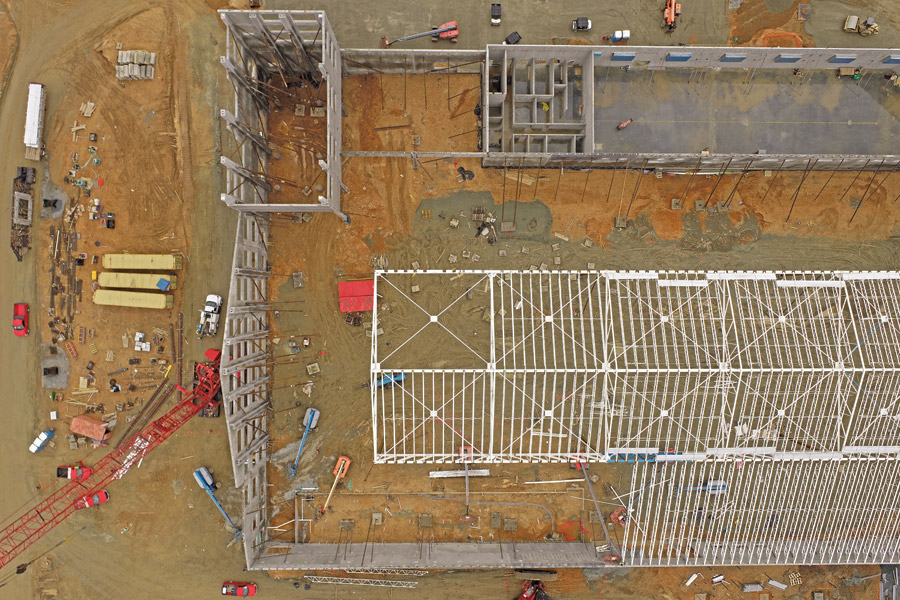
Work on the water park took priority on the critical path.
Photo by Multivista, courtesy of Turner Construction Co.
Hopeful Sign
The project broke ground nine months after vaccines became available for children, which at the time was a hopeful sign that some pandemic concerns were easing, and an anecdotal indicator that business was starting to return to some semblance of pre-pandemic levels. Former Maryland Gov. Larry Hogan (R) said in a July 2021 statement when the resort broke ground that the project was “yet another shining example that our state economy is coming back stronger and better than ever before.”
The project reached substantial completion in late May, one month ahead of schedule and is slated is open this month. Despite budget challenges, Richardson says the team’s extensive value engineering efforts delivered a combined $3.5 million in savings for Great Wolf Resorts.
“It has been a long and challenging journey, but we got there,” Pigozzi says.


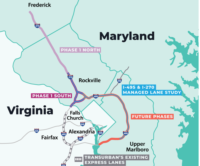
Post a comment to this article
Report Abusive Comment